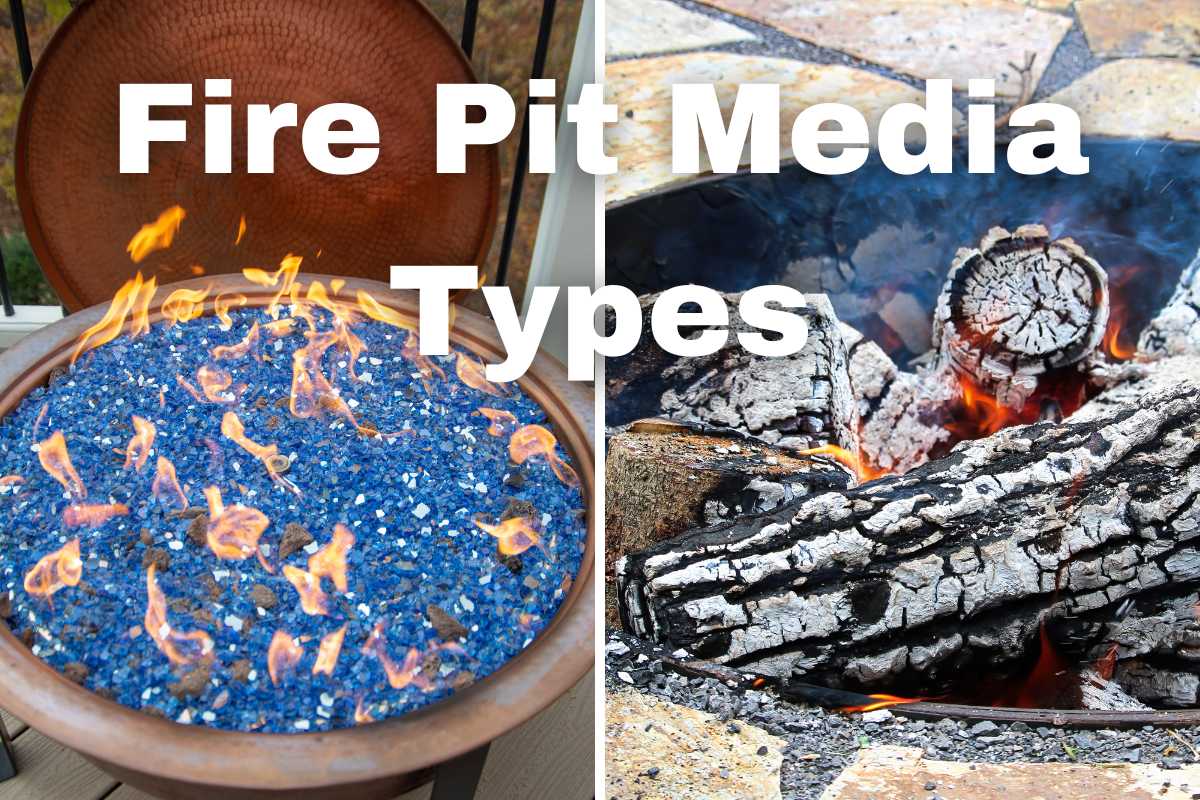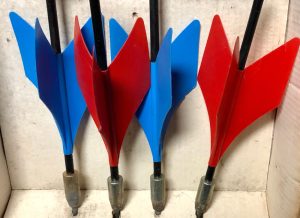Ready to dive into the world of fire pit media? Well, in this guide, we’ll explore the various options and how they can transform your gas fire feature in various ways. The aim is to make your fire pit look pretty while keeping you warm and cozy.
Now, fire pit media includes materials used to fill up the burner of a gas fire pit or fireplace. We’re talking fire glass, lava rock, river rocks, and even ceramic cannon balls. These materials are specially made to withstand intense heat. They give your gas fire pit that natural look of a wood flame but without wood.
Without the media, the flames tend to bunch up in certain spots where the gas comes out, leaving you with an uneven fire.
That’s where the media comes in handy. It helps spread out the gas flow and the flames nicely and evenly. This gives your fire a downright realistic, and natural look. Plus, it covers up the pan and gas jets for a polished look.
When it comes to using the media, you generally want to cover that burner with about an inch of the material.
But keep in mind, the specifics may vary depending on the type of burner. Don’t go overboard with the media. Too much of it can block the flow of gas and air from that burner.
But each fire feature has its own unique requirements. Some come with a recommended amount of fire media you can safely use. It’s always a good idea to take a gander at the user manual for the specifics.
Fire Pit Media Options
There are various types of fire media available which we’ll cover below.
1. Ceramic log set
If you prefer a more traditional and realistic wood-burning appearance, you can stick with a log set usually included with most fireplaces.
Log sets tend to be a favorite for many. They are specifically designed to replicate the natural appearance of wood while offering a cleaner and more efficient burning experience. When you burn them, there won’t be any ash or embers generated, which makes for easier maintenance.
Ceramic Logs for Propane or Gas Fire Pit
Made from high-quality ceramic fiber, fireplace logs truly looks like real wood burning logs and disperse the flames nicely. Once they warm up they literally glow deep red and generate heat, warm and cozy
Pros
- 10 different sizes
- These gas logs burn clean
- Large capacity suitable for a family of up to 6
- Withstand up to 1832°F
- Great price
Cons
- Logs are small
- Look a little fake
- Better for smaller firepits
To achieve the desired aesthetics, these logs are positioned over lava rock. They are carefully arranged over the burner area. This helps shape the fire, giving it a cozy and inviting atmosphere.
Gas logs are available in various styles and sizes. But over time, some soot may accumulate on the logs, especially if you have lighter-colored ones. However, this is natural and adds to the character of your fire pit.
2.Lava rock
Lava rock is a popular choice for gas fire pits and fireplaces. It is a product naturally formed from volcanic magma. These dark rocks typically measure around 1 to 2 inches in diameter, creating a striking contrast against the flames.
Venetian Princess Lava Rocks
These Lava Rocks can be used in outdoor fire Pits and also indoor fires. They come in varies sizes and are naturally formed. Lava Rocks can be used in Outdoor Fire Pits, Fire Bowls, or Fire Tables
Pros
- Size ranges from 1/2″ to 1-1/2″
- Available in Black or Red
- Lava Rocks is heat proof
- Available in 10 Pounds or 40 Pounds Bags
Cons
- Each rock is small
- We found sand mixed in the bag
- Better for smaller firepits
Its natural coloration is typically brownish-black with subtle red hues, effectively concealing any soot marks that may appear. The lava rocks may naturally fade over time developing a grayish hue. Occasional cleaning may be necessary to restore its color.
It offers a range of benefits, including fire safety, heat resistance, and minimal maintenance requirements. With its porous structure, lava rock ensures excellent air circulation and efficient heat retention.
While lava rock is generally rough and coarse, there can also be tumbled for a smoother and polished appearance.
Lava rock offers versatility. It may be used as a standalone material or a base filler for fire glass or gas logs. When using lava rock, it’s important to arrange it in a way that covers the nozzles without obstructing them. Blocking the nozzles can result in a whistling sound when the fire is turned on.
3. Fire Glass/Fire beads
Fire glass, crafted tempered glass, is a popular choice as a fire pit media. It serves only as a decorative element adding a vibrant splash of color to your fire pit. What’s more, its reflective surface further amplifies heat radiation, enhancing the heat output.
Fire Glass
Can be used in an indoor or outdoor fireplace that uses propane gas, natural gas or electric; can also be used in indoor glass fireplaces, outdoor firepits, fire tables, and fish tanks.
Pros
- Wide Range of Use
- No Melting or Fading
- The glass itself does not burn
- Smooth glass reflective surface makes flames flicker vibrantly.
Cons
- Some have sharp edges
- Hard to clean
Designed specifically for high-heat applications, fire glass maintains its integrity, retaining its original color and shape without producing any harmful byproducts when used correctly.
Available in various sizes, typically ranging from ½ to 1 inch in diameter, fire glass also comes in a wide array of colors. You can choose from crushed, reflective, and smooth glass options to achieve the desired aesthetic. For a truly unique look, feel free to mix different colors together.
Fire glass can be strategically placed in the central area of your fire pit pan, covering the entire top surface.
Also, you can opt to position it over an aluminum screen atop a bed of lava rocks. Whichever method you choose, the glass will infuse your fire pit with a captivating sparkle, adding a distinct touch that can be customized to suit your preferences.
As the flames dance, the glass beautifully reflects the flame’s light, casting an alluring luster and introducing an enticing texture.
To keep your fire glass looking its best, regular maintenance may be necessary. This can involve simple cleaning and occasional adjustments.
4.River rock
River rocks are specially crafted cast (man-made) stones that are intended for use in gas fire pits. Unlike natural river rocks, which can crack or explode when subjected to intense heat, these alternatives are safe and reliable.
Fireproof and Heatproof Round Pebbles
Improves performance by spreading gas dispersion in all directions, ideal on its own or as a base layer underneath fire glass, or even mixing the lava and glass together.
Pros
- GAS COMPATIBLE
- ECO-FRIENDLY AND SAFE
- GUARANTEED HEAT-PROOF
- HASSLE-FREE INSTALLATION
Cons
- Various sized rocks
- Some bags only had smaller rocks
- You need at least 2 bags for a larger firepit
They contribute to a realistic and contemporary aesthetic, adding a touch of sophistication to your fire pit. Available in light or dark gray hues, they effortlessly blend into various design schemes.
Placing them over the burner area allows you to shape the flames and create a distinctive look that complements your overall fire pit arrangement.
WARNING: Lava rock may pop or crack while adjusting to changes in temperature. Please cover your fireplace or fire pit during the first few uses.
5. Cannonballs
Ceramic cannon balls, also referred to as fireballs, are lightweight spheres made of ceramic fiber. They possess the remarkable ability to create an incredibly lifelike appearance when placed in a fire pit.
Fire Pit safe Cannonballs
Bring a new stylish look to your dated fire pit or fireplace! Great fire ball for fire tables, cement fire bowls, indoor / outdoor fireplace & more!
Pros
- Suitable for use in temperatures up to 1600 degrees!
- Quantity 15 of the 3″ inch Diameter Fire Ball Spheres
- Lightweight
- Longlasting
Cons
- Hard to clean
- Only 15 per bag
- Flames Burn and stain them after time
With a range of sizes, shapes, and colors available, you have the freedom to mix and match them, allowing for endless creative possibilities and visual interest.
As the ceramic balls are exposed to the fire, they will naturally darken over time. This darkening occurs as a result of the soot produced by the gas, particularly in propane fire pits. The balls themselves do not burn; rather, the darkening is solely due to the presence of soot from the gas.
You may also like ?
-
10 Best Vegetables To Grow In The Winter
-
How To Heat Greenhouse In Winter (6 Proven Methods)
-
Lavender In Winter Guide (What To Expect)
-
Guide To Desert Plants: Types, Adaptations, And Landscaping Tips
-
Philodendron Care, Varieties, And Aesthetic Home Arrangements
-
Potato Bugs: Identification, Impact, And Control
To Wrap Up ?
Each of the available options possesses unique characteristics that enable you to customize your fire pit according to your preferences.
When selecting the ideal fire media, it’s important to consider the overall theme of your space. Additionally, don’t be afraid to experiment and make changes to suit your evolving preferences.






